Alexei Leonov: The Russian who could have been first to the Moon
- Published
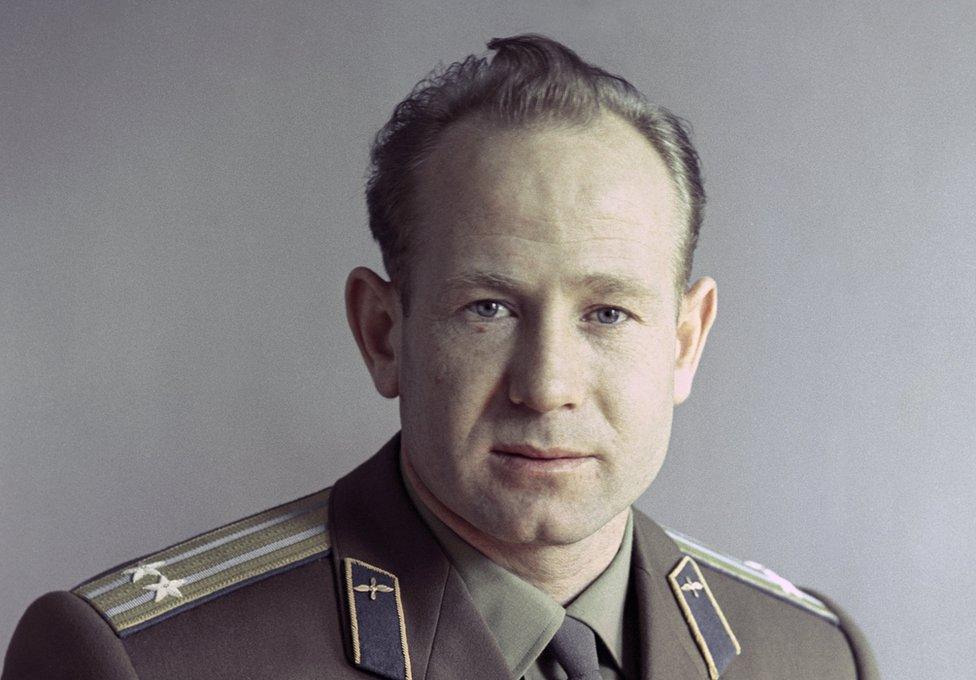
Pioneering cosmonaut Alexei Arkhipovich Leonov died on Friday in Moscow aged 85. With his passing, the world has lost another direct connection to the Cold War space race of the 1960s and 70s.
Leonov was widely admired by other astronauts and cosmonauts, and his exploits in orbit were legendary.
He was also regarded as a man of great compassion, who was deeply affected by the deaths of his colleagues and friends in the ground-breaking but perilous contest in space between the superpowers.
Yet his passion for art made him somewhat atypical of the "steely-eyed missile men" who made up the astronaut and cosmonaut corps during the 1960s.
His hobby was not always a good fit with the technocratic nature of the Soviet space effort. The head of the USSR's rocket programme in the 1970s, Vasily Mishin, became convinced that a problem with the world's first space station, Salyut-1, had been caused by one Leonov's drawing pencils floating into the ventilation system and getting stuck. A subsequent mission to inspect the station disproved the idea.
Ultimately, Leonov will be remembered as the first person to walk in space. But if things had gone differently, the Russian might have become the first person to walk on the Moon.

The First Spacewalk

Read the story of the first spacewalk, and how the mission nearly didn't come back to Earth.

Born in the Siberian village of Listvyanka in 1934, Leonov was a boy when his father was jailed in Stalin's purges. After being encouraged by the authorities, neighbours lined up to ransack the Leonovs' home - as the family looked on.
Despite the artistic promise he showed growing up, Leonov graduated as a fighter pilot. A few years later, he was selected to be one of the USSR's first class of 20 cosmonauts, alongside Yuri Gagarin who, in 1961, became the first person in space. The two became the best of friends.
In March 1965, Leonov got his first flight on Voskhod-2, the first spacewalking mission. Tethered to the spacecraft with a 4.8m-long (16ft) cable, he clambered out of an inflatable airlock, pushed himself away and floated above the Earth.
The planet stretched out in all directions like a glorious panorama. In 2014, Leonov told the BBC it made him feel "like a grain of sand".
But the first excursion outside of a spacecraft did not go as planned - Leonov soon noticed that his suit was inflating.
"My hands had slipped out of the gloves, my feet came out of the boots. The suit felt loose around my body," Leonov said.
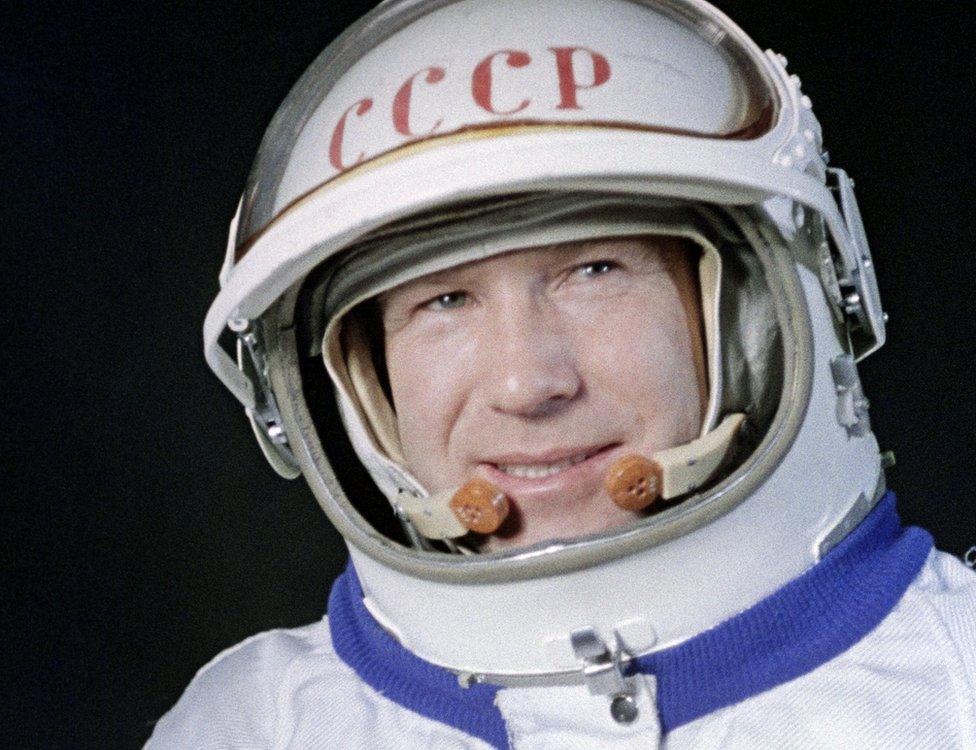
Leonov's spacesuit inflated during his spacewalk in March 1965
He made it back inside the craft, but only after bleeding half the air out of his spacesuit which gave him the early symptoms of decompression sickness, also known as "the bends".
The mission ran into other emergencies following the spacewalk, and the cosmonauts had to make the first return to Earth under manual, rather than automatic, control. It worked, but the spacecraft landed in the snow-covered Ural mountains, far away from the intended landing site. Leonov and fellow crew-member, Pavel Belyayev, had to endure freezing conditions until a rescue party located them.
During Voskhod-2, Leonov proved he had the "right stuff" in spades - calmly troubleshooting a complex and life-threatening problem. Unsurprisingly, he was later selected to command the Soviet Union's first attempt to land on the Moon.

Gagarin (L) and Leonov (R) were the best of friends
While the successes and failures of America's Apollo programme took place under the harsh glare of publicity, the Soviet Union was working away on its own lunar effort in secrecy.
The USSR's plan to land on the Moon shared many similarities with Apollo, but there were key differences, too.
"Unlike Apollo, our lander carried only one cosmonaut. It was more difficult of course, but that's how the mission was designed," Leonov said in an interview for the Science Museum's website., external
"When approaching the Moon, I would have to spacewalk from the descent module into the lunar lander. At a set time, the spacecraft and the lunar descent module would separate. I would be the only person on the lunar lander."
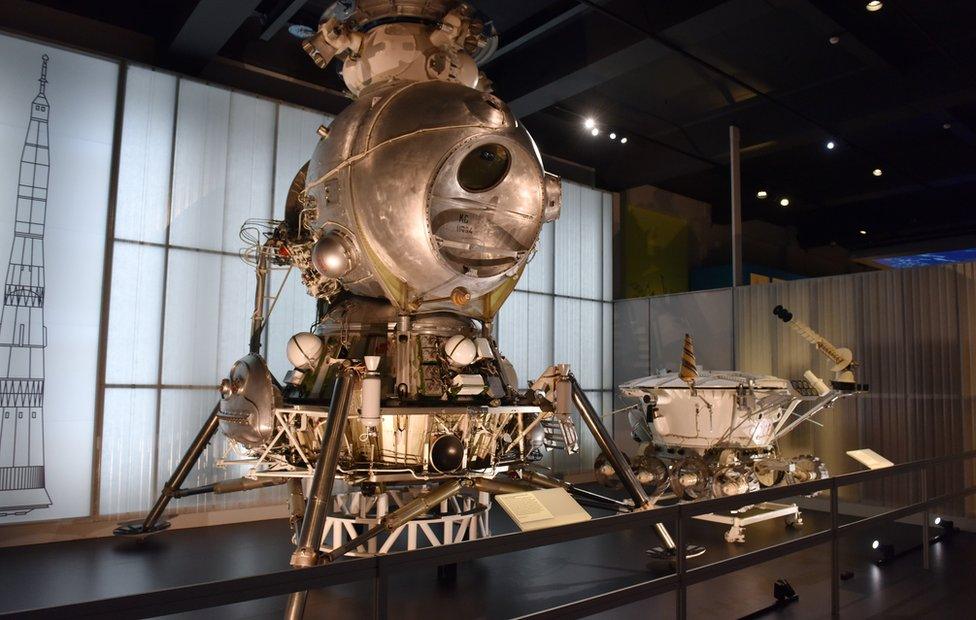
A LK-3 lunar lander training module on display during the Cosmonauts exhibition at London's Science Museum
The Russian trained for landing on the Moon in a modified Mi-4 helicopter. At 110m above the ground, he stopped the helicopter's engine and landed it in autorotation (where the rotor turns only by the action of air moving upwards through it). At this height, the chopper matched the vertical speed of a lander during its descent to the lunar surface.
"It's a crazy idea, extremely dangerous. But I did nine of these landings," Leonov told the BBC's Cosmonauts documentary in 2014.
However, the effort was dealt a blow in 1966 when Sergei Korolev, chief designer and driving force behind the Soviet space programme, died during what should have been a routine operation. The programme lost its momentum after his death.
In addition, the Soviets couldn't get their huge Moon rocket to work. The N-1 stood 105m (345ft) tall and was the USSR's answer to Nasa's Saturn V launcher. The N-1 had a first stage powered by 30 engines arranged in two rings, while the Saturn V had just five engines.
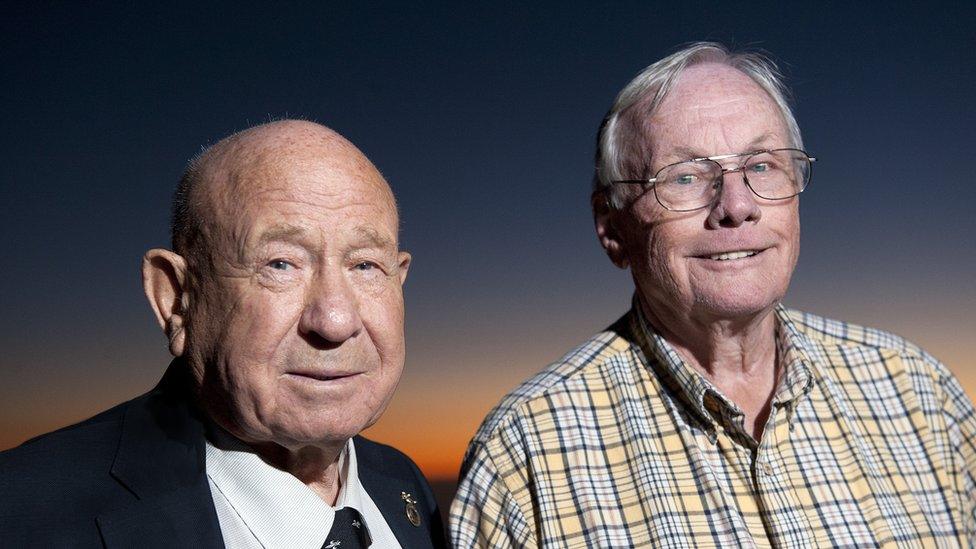
If things had gone differently, Leonov (L) might have been first to walk on the Moon instead of Neil Armstrong (R). This photo was taken in June 2011 at a festival in the Canary Islands
The design of the N-1, with many smaller engines clustered together, meant that if just one experienced a destructive failure, it could take out all the others. This meant the system reliability for the N-1 had to be much better than the Saturn V's.
All four launches of the Soviet rocket ended in catastrophic failure. But Leonov remained convinced that, had Korolev lived, the problems with the N-1 would have been swiftly corrected.
After Armstrong and Aldrin touched down in the Moon's Sea of Tranquility on 20 July 1969, the USSR cancelled its Moon shot.
The cosmonaut was hit by numerous tragedies during his life. One was the death of his good friend Yuri Gagarin in a plane crash. On 27 March 1968, Gagarin took off in a Mig-15 plane from a military base outside Moscow on a routine flight to re-verify his pilot skills.

Gagarin was killed in a plane crash in 1968
However, the plane did not return. Leonov joined the search for Gagarin in the forest surrounding the base, and identified his friend from what was left of his body.
In Two Sides of the Moon, the book he later co-authored with Nasa astronaut Dave Scott, Leonov said Gagarin had been like a brother to him: "Death had never seemed closer, nor more terrible," he wrote.
"In the years since, I have made many drawings and paintings of that awful crash site; the torn trees, smoke, wreckage."
The first spacewalker refused to believe rumours that Gagarin had been drinking, or the conclusion of the official investigation - that the plane had collided with a hot air balloon.

The crew of Soyuz 11 were killed during re-entry. From left: Viktor Patsayev, Georgi Dobrovolski (reclining) and Vladislav Volkov
Instead, he spent years promoting his own theory that, in agreement with eyewitness reports, a supersonic jet was being tested in the same area on the day. He believed the jet's pilot had passed too close to Gagarin's plane while travelling at supersonic speeds. This had caused the MiG to overturn and crash.
In 1969, Leonov narrowly escaped injury when a Soviet army deserter opened fire on a chauffeur-driven limousine he was in. The car was travelling through Moscow as part of a motorcade carrying Soviet premier Leonid Brezhnev, who had been the assassin's intended target. The limo's driver was killed by one of the bullets.
By the early 70s, the Russian had been assigned to command a mission to the world's first crewed space station, Salyut-1. However, the prime crew was replaced with a backup team when one of the cosmonauts, Valeri Kubasov, showed possible signs of tuberculosis during a medical exam (it turned out to be an allergy).
The backup team had little time to train before the launch; Leonov protested the decision but was rebuffed by superiors.

The crew of the Apollo-Soyuz Test Project. From left: Slayton, Stafford, Brand, Leonov, Kubasov
The Soyuz 11 mission launched in 1971, and all went well until it was time for the cosmonauts to return. The Soyuz capsule had air vents between two modules of the spacecraft. These were supposed to automatically close for re-entry and then open again once the capsule was at a safe altitude. But Leonov suspected they were a design weakness and warned the crew to shut them manually before returning to Earth.
Unfortunately, the procedure was missed. The vents opened prematurely and all three cosmonauts died within seconds as the air was sucked from their cabin. Leonov later wrote: "Even though it was not my fault, I blamed myself for what had happened."
After the Apollo 11 Moon landing, Cold War tensions had eased between the US and USSR. In a move that would once have been unthinkable, the two countries agreed to collaborate on a space mission, called the Apollo-Soyuz Test Project. The two superpowers would separately launch spacecraft that would then dock in orbit.

Painting by Leonov of the Apollo spacecraft docked to the Soyuz
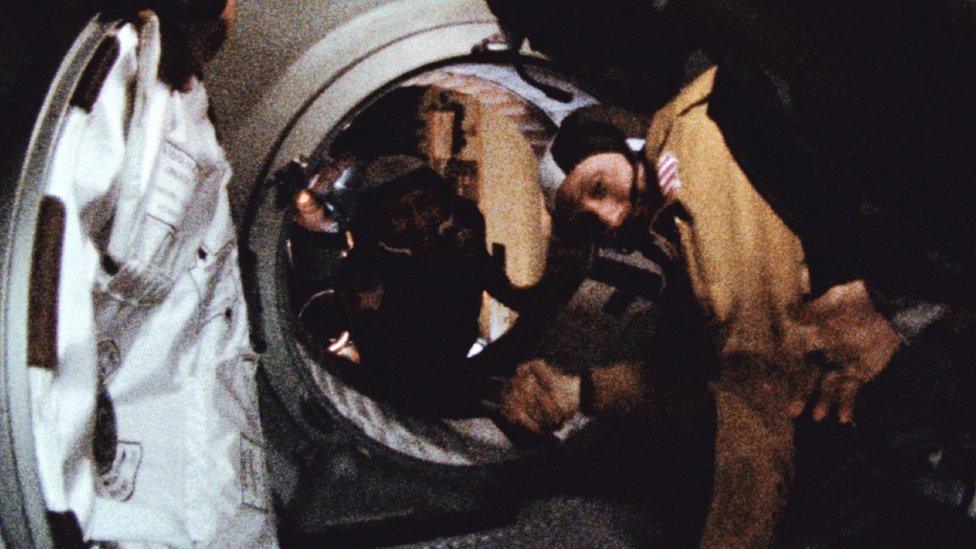
The historic handshake between Leonov (L) and Stafford (R)

Leonov (R) with Deke Slayton during the flight
Leonov commanded the Soviet side of the mission, and was joined by Kubasov.
The Americans' side of the mission was led by Thomas Stafford, a veteran of three spaceflights. He was joined by Vance Brand and Deke Slayton, both on their first spaceflight.
After the two spacecraft linked up, Leonov moved into the joint docking module and waited for the Nasa astronauts to open their hatch. He was greeted by Stafford and, for the first time, a Soviet made direct contact with an American in orbit.
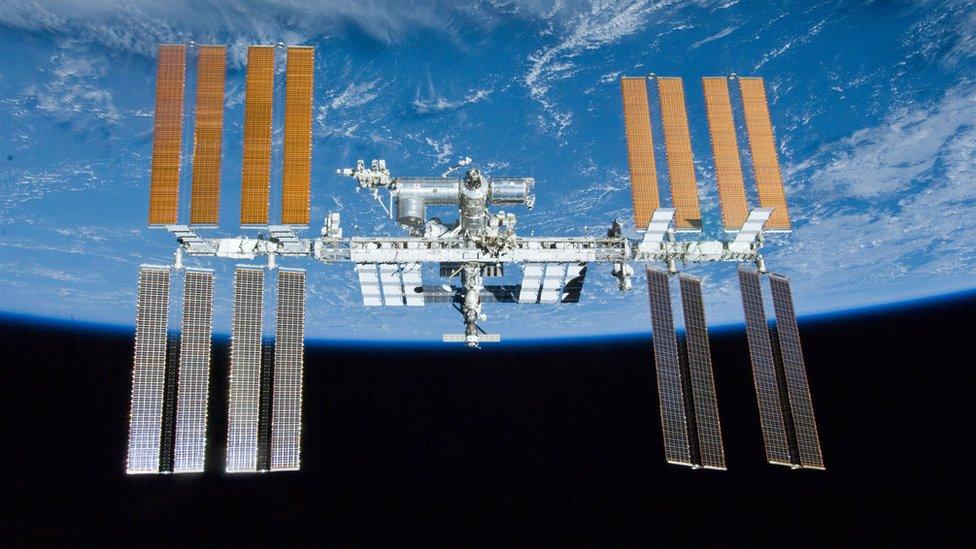
ISS: The Apollo-Soyuz Test project paved the way for further collaborative projects
During the two days the spacecraft remained docked, the three Americans and two Soviets exchanged flags and gifts, visited each other's spacecraft and ate together.
The two crews were required to learn the other's language - and Leonov would later joke that the crews had spoken Russian, English and "Oklahomski", referring to Stafford's Oklahoma accent.
The mission was a first baby step towards greater co-operation in space between the two nations. It paved the way for other collaborations on the Soviet space station Mir and, eventually, the International Space Station (ISS).
After the Apollo-Soyuz mission, Leonov became chief cosmonaut and was deputy director of the Yuri Gagarin Cosmonaut Training Center outside Moscow where he oversaw crew instruction.
He died at Moscow's Burdenko Hospital after a long illness. He is survived by his wife Svetlana and daughter Oksana.
Follow Paul on Twitter., external